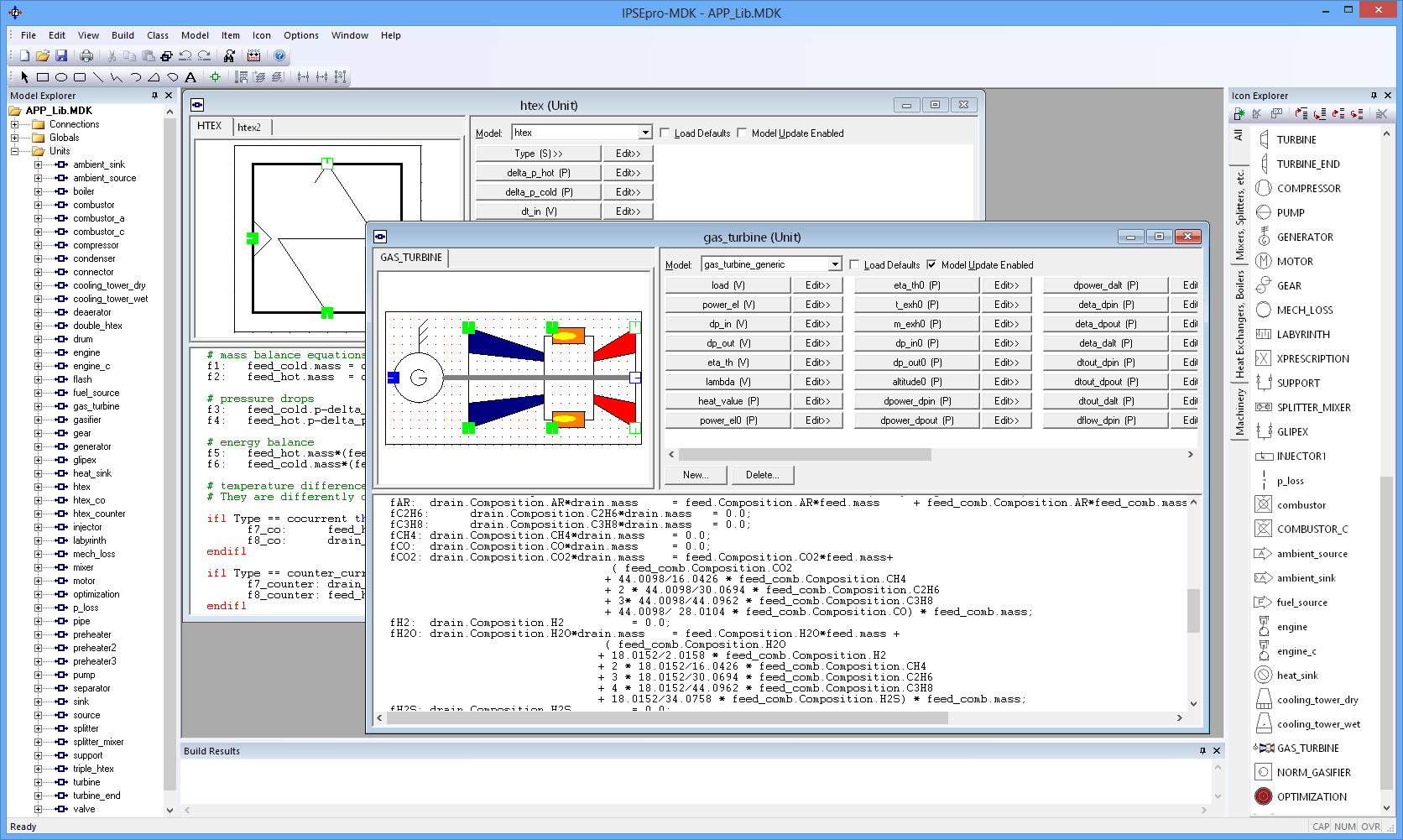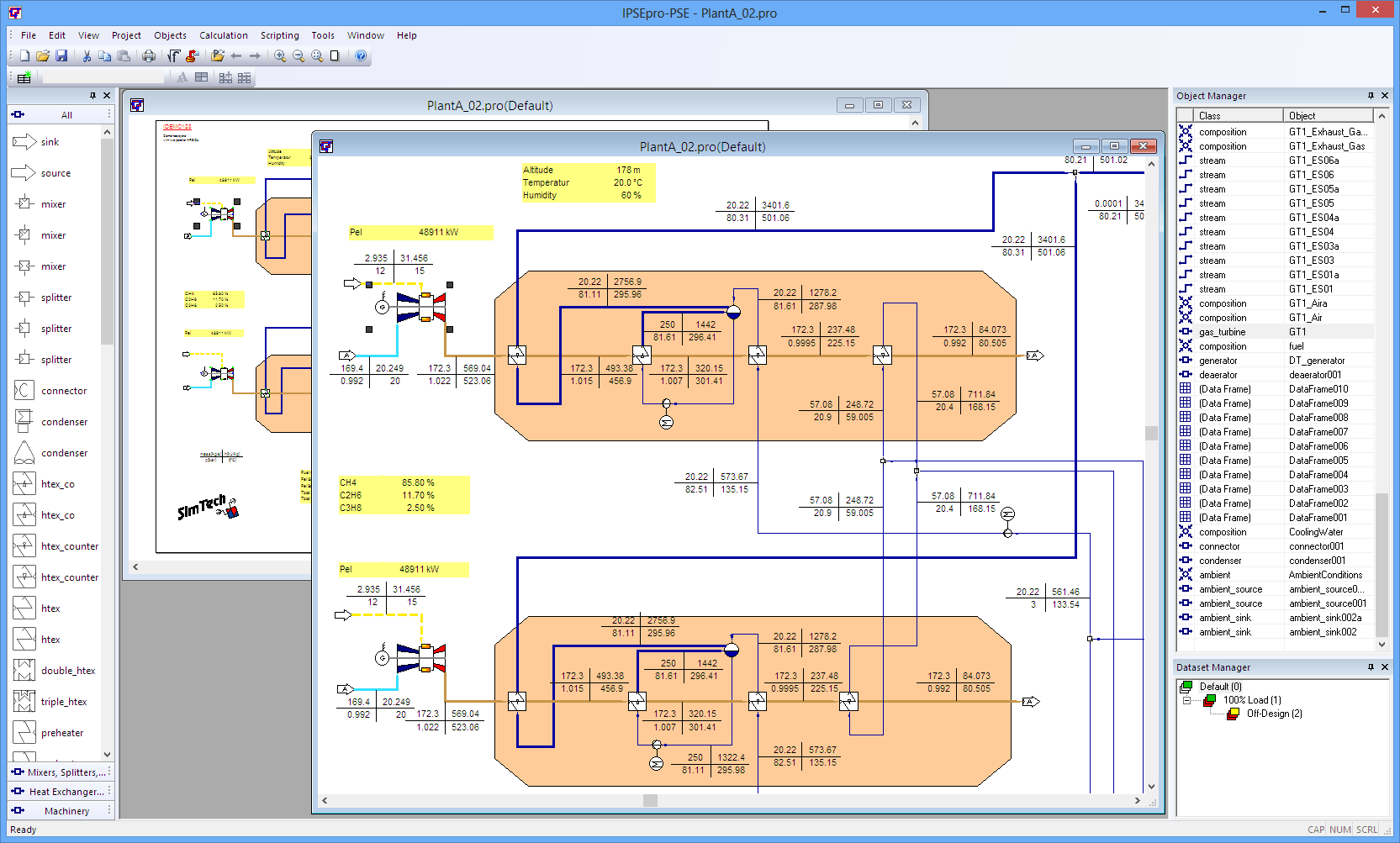IPSEpro System Description
IPSEpro System Description
IPSEpro System Description
Many engineering systems have the structure of a network of discrete components connected together. Such a network may, for example, represent a power plant or a network of heat exchangers. It may also represent equipment that is split into smaller elements. Mathematically, these networks are represented by systems of equations. IPSEpro is a powerful environment that allows to set up models of such networks graphically (“flowsheets”) and to solve the resulting set of equations.
Many engineering systems have the structure of a network of discrete components connected together. Such a network may, for example, represent a power plant or a network of heat exchangers. It may also represent equipment that is split into smaller elements. Mathematically, these networks are represented by systems of equations. IPSEpro is a powerful environment that allows to set up models of such networks graphically (“flowsheets”) and to solve the resulting set of equations.
IPSEpro Modeling Concept
A sophisticated and yet intuitive modeling concept is the foundation of IPSEpro’s power and flexibility.

IPSEpro is based on the concept of “standardized” components that are used to build the model of a complete process. Each model is mathematically represented by a set of equations and variables. To build the mathematical model of a process means to join all equations of the component models into a single system of equations.
How to use IPSEpro?
The key to IPSEpro’s flexibility is its concept of model libraries: IPSEpro can be customized for specific technology areas simply by loading an appropriate model library. Most users will start with one of the many available standard IPSEpro libraries, but since users can create their own libraries, there are virtually no limits to the application of IPSEpro. Thus, IPSEpro allows flexibility at two levels:
- The component level
- The process level
IPSEpro’s System Structure
IPSEpro provides efficient data management, powerful mathematical methods, and an intuitive graphic interface (based on Windows) so that the user can fully concentrate on the technical aspects of his problems.
The Component Level Flexibility
IPSEpro provides unlimited flexibility in defining the characteristics of the component models that are used for modeling processes. This allows the user to build component model libraries that exactly match his application requirements.
The model building process is easy and interactive. The user designs his models mathematically and graphically within MDK, IPSEpro’s Model Development Kit.
The user can modify and customize existing component models from standard model libraries, if required.

The Process Level Flexibility
IPSEpro allows complete freedom in arranging the available components in order to represent a process scheme. A graphical user interface facilitates and accelerates substantially the development of process schemes, and the presentation of the results of calculations.

To set up a process model, the user chooses component icons from a library menu, places and connects them appropriately in the project window of PSE, IPSEpro’s Process Simulation Environment. Numerical data and results of process calculations are entered and displayed directly in the project window.
IPSEpro allows the user to simulate the behavior of single elements of processes, of parts of a process and of models of complete plants. IPSEpro provides efficient data management, and uses robust algorithms that devise extremely short calculation time.
With IPSEpro, multiple datasets
can be associated with a single process diagram. Typically, one dataset could be used to set up the design process model, and other datasets could be used to represent alternate designs or performance under off-design conditions.
IPSEpro’s Structure
The structure of IPSEpro with its main modules MDK and PSE has the advantage that the flow of data is well defined.
In a production environment, the models in a library typically represent an established modeling standard. Modifications of the models in library may have far reaching consequences. Changes should therefore only be made by authorized and qualified users. This is achieved by restricting the usage of MDK to these authorized users.
Frequently the author of a model library is different from the actual user of the library. The user of the library will then only use PSE, so that accidental changes of the library are not possible.
It is possible to compare a model library with a program written in a traditional programming language. Only one or few qualified persons have access to the source code, while a much larger number of persons are using the executable code.
In research and development, model libraries are considerably more dynamic. Therefore users should have full access to both PSE and MDK.
IPSEpro versus traditional programming languages
IPSEpro has proven to solve efficiently a wide range of modeling problems that would otherwise require coding in a traditional programming language like FORTRAN, BASIC or C++.
Using IPSEpro instead of a traditional programming language has a series of benefits.
Advantages
- Short implementation time.
- Users need not to be programmers.
- A uniform environment for a wide range of problems.
- New components are easily integrated into an existing system.
- The user can concentrate on the engineering details of their problem.
- State-of-the-art numerical methods are built in.
- Comfortable graphical user interface without extra costs.
- Low maintenance costs.
RECEIVE MORE INFORMATION ABOUT ENGINOMIX PRODUCTS AND SERVICES:
Enter your information below to access sample models and to receive more information about Enginomix Products and Services.
Thank you for contacting us.
We will get back to you as soon as possible
We will get back to you as soon as possible
Oops, there was an error sending your message.
Please try again later
Please try again later

